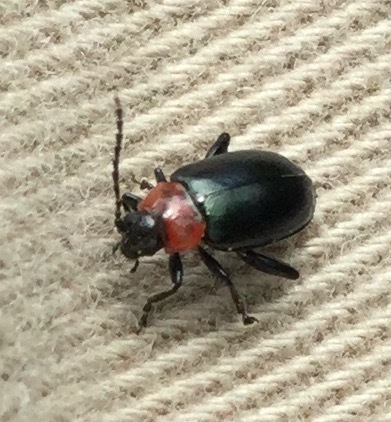The Wrack
The Wrack is the Wells Reserve blog, our collective logbook on the web.
The Wrack is the Wells Reserve blog, our collective logbook on the web.
The mere mention of ticks gives me the heebie-jeebies. I feel one crawling up my shin, my calf, my neck. I itch and check and itch and check and typically find nothing.

At the height of spring migration, I took my lunch across the fields, through the scrub, and down the hill to the aspen grove. At the crossing, I turned on the Pilger Trail. A bench right there makes a nice stop with a sandwich, especially when warblers are on the move. I've picked up magnolia, parula, Nashville, Wilson's, and, once, a worm-eating in this productive spot.
On this day, though, birding was slow. A few residents and a couple of migrants kept me company, but there was no warbler wave, no stream of species flitting branch to branch.
I stood and scanned the crowns of cherry trees. I sat and stared at thickets of barberry, honeysuckle, and rose. I chewed and gazed at the sky. Now and then I lowered my chin to counteract warbler neck.
That's when I saw it, a dark speck low on my pant leg. Evil.
Using the bench as a foot prop, I got the little critter close enough to pinch. But my assumption was off; what I found wasn't a tick. I puzzled over the black nub for a few seconds, stopping short of flipping my binoculars to make a microscope. Instead, I took a couple of unsteady close-ups with my iPod and returned to birding. The bug, judged unmenacing, was photo'd and forgotten.

That night I decided to look it up, but what do I know about bugs?
Well, I know one thing: A lot of little crawly things get called bugs when, technically, they shouldn't. And what my fuzzy photo showed me were wing covers meeting in a straight line, mandibles obvious at the mouth, and an antenna with many segments. A beetle, not a bug; in the order Coleoptera, not Hemiptera.
| Bugs | Beetles |
|---|---|
| outer wings often hardened outer wings do not fully cover inner wings outer wings form an X | outer wings hardened (elytra)
outer wings fully cover inner wings outer wings often meet in a straight line |
| mouth parts for piercing and sucking proboscis folded under body at rest | mouth parts for chewing mandibles visible |
| life stages: egg - nymph - adult (hemimetabolous) | life stages: egg - larva - pupa - adult (homometabolous) |
| 4-5 antenna segments | up to 11 antenna segments |
| Order Hemiptera (half wing) | Order Coleoptera (sheath wing) |
More specifically, my minuscule critter had a black body and a black head but a brick-red thorax. Not much to go on when North America hosts more than 25,000 beetle species and Maine at least 2,871. I clicked through pages of pictures on bugguide.net — photo-matching is a slog — eventually narrowing my specimen down to "leaf beetle" but getting no further before bedtime. I uploaded a crop of my photo to iNaturalist and the next day had an ID: Spinach Flea Beetle Disonycha xanthomelas. I was right about leaf beetle, but "fernbee" and "e-aus-kanada" were able to take it from family (Chrysomelidae) to tribe (Alticini) and right down to species.
So what was a spinach flea beetle doing at a brushy lunch spot near the start of the Pilger Trail? Obviously they're not restricted to spinach; there must be some other suitable leaf to chew down there. These beetles are also known to be fond of mustards and nightshades, two diverse plant families that surely have representatives somewhere in that tangle.
This tiny non-tick took me by surprise then sent me on a path of discovery. It landed on my leg then the Internet. It gained a label and got geotagged, becoming part of the scientific record. It reminded me I shouldn't be so paranoid about Powassan and Lyme that I vilify every little creepy crawly. After all, those warblers need something to eat on their way through each spring.